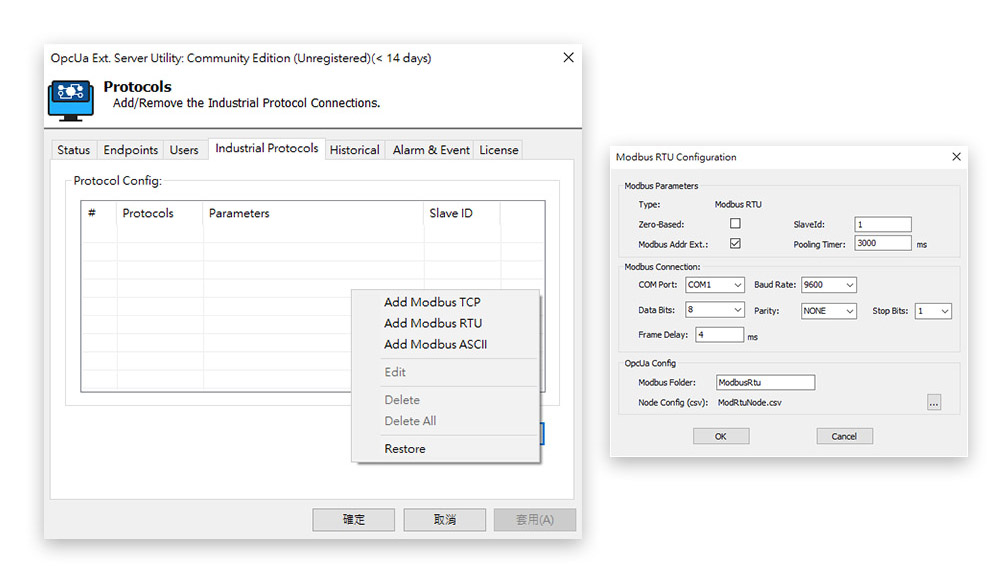
AIC OpcUa Extender Server 設備聯網智動化軟體套件(支援多台PLC連線)
成就不凡的工業物聯網與大數據訊息收集中心
- 簡單串連Modbus/TCP、Modbus/RTU和Modbus/ASCII等設備
- 以微軟Windows帳號登錄和認證達成多用戶身份驗證
- 由使用者定義的數據結構和資料模型
- 完整的數據記錄器、歷史數據訪問、報警和事件功能
- 支援最多1000個客戶端連線
- 能儲存成MySQL、MS SQL、Azure SQL和.csv檔案
- 支援最多1000個歷史資料序列,採樣頻率為500毫秒
- 提供用於資料存取和節點設定的RESTful API

AIC OpcUa Extender Server 設備聯網智動化軟體套件(支援多台PLC連線)


AIC OpcUa Extender Server是一個專注於與系統進行數據收集通信的開放平台通訊統一架構(OPC UA)伺服器套件。基於OPC UA通訊模型,我們提供了所需的數據收集平台,讓用戶可以利用OPC UA的服務導向架構將其複雜的數據組織到OPC UA命名空間中。AIC OpcUa Extender Server具有標籤訂閱和實時更新等功能,作為通訊閘道,它在允許OPC UA客戶端操作人機介面(HMI)或可編程邏輯控制器(PLC)數據方面發揮著重要作用。AIC OpcUa Extender Server包括可配置的GUI用於參數和設置,以及作為數據收集和發送至OPC UA客戶端應用程式的中心的OPC UA伺服器服務,從而實現了簡化的OPC UA系統操作。
AIC OpcUa Extender Server為一套工業用通訊協定標準,能使機器與機器間(M2M)的數位資料進行交換,OPC UA一開始發展可溯及1996年OPC基金會的OPC(Open Platform Communications)是用於工業自動化的通訊協定標準,符合OPC標準的設備透過OPC將即時資料傳送給Server端,使用者透過Client端來取得即時資料,以完成即時監控設備,為基於微軟Microsoft系統的基礎,定義了程式化控制與工廠自動化的所需要的物件,可以整合軟硬體設備管理介面,可以說OPC UA是為工業智動化而生的協定,可以整合ERP、MES、SCM等電子化企業所需要的軟體服務,同時將資料採集與監視系統SCADA(supervisory control and data acquisition)、人機界面HMI(Human Machine Interface)、可程式自動化控制器PAC(Programmable Automation Controllers)、可程式化邏輯控制器PLC(programmable logic controller)、PC-based控制器、直接數位控制器DDC(Direct Digital Control)等硬體設備進行M2M的聯網功能。
AIC OpcUa Extender Server 軟體是否需付費
Community社群版為永久免費版,Standard標準版、Professional專業版與Enterprise商務版為付費版,歡迎您優先使用永久免費版,立即下載。
AIC OpcUa Extender Server 功能
基於機器到機器(M2M)的通訊處理,以AIC OpcUa定義兩台乃至於多台設備間的資料傳輸,可以是有線的傳輸亦或是無線的傳輸,屬於物聯網傳輸的功能,不僅于智慧設備間的數位傳輸與資料交換,也包括感測器與致動器的數位訊號傳輸,由地端經過邊緣運算後再傳輸至雲端,以進行複雜的工廠資料傳輸與分析作業,在工業4.0趨勢下由自動化發展至智動化成就所謂「智慧工廠」,具有自行優化工廠的生產流程且具有擴展的能力,不需要人力的干涉,可以即時追蹤設備在整個生產過程、使用週期、稼動率與累積生產價值與創新,皆能通過AIC OpcUa部署物聯網進行學習。
AIC OpcUa Extender Server 開發環境
為開放式標準統一架構以規範並簡化機器對機器(M2M)的通訊,能在任何作業系統上運作,包括Windows、Linux、MacOS、iOS與Android,並提供全面的API介面,能輕鬆介接不同的應用軟體,具有平臺獨立性不依賴任何程式語言或應用平臺。
AIC OpcUa Extender Server 通訊協定架構
提供兩種通訊模式,獨立於實際的通訊協定,以TCP和HTTP用於用戶端-伺服端(client/server)與發佈-訂閱模式(pub/sub),OPC UA最底層為完整的IP空間、變數結構與警示模式,第二層為協定層提供TCP與HTTP的設定,第三層為程式語言的使用,即Python、Java、.NET和Ansi/C++語言,第四層為API串接層。使用三種編碼方式:UA Binary、JSON、XML依opc.tcp://方式進行連線。
AIC OpcUa Extender Server 統一架構提供下整合性內容:
1、 即時資料造訪規範(OPC DA):主要收集設備端的即時資料,以DCOM方式傳輸至遠端儲存系統,如:MES、SCADA等。
2、 歷史資料造訪規範(OPC Hda):對於設備端己封存的歷史資料,傳輸到分析的應用程式。
3、 警示事件提示規範(OPC A&E):其能定義警示事件的傳輸規則,也可以定義變數的條件。
4、 OPC 安全協定。
將過去OPC所提供的分散全部整合於OPC UA中。





- 2
- 10
- 100
- 5,000ms
- 1,000
- 10
- --
- 10
- --
- --
- 永久授權
- 20
- 128
- 1,000
- 1,000ms
- 2,000
- 64
- O
- 100
- --
- PAICH10060024
- 永久授權
- 100
- 512
- 4,000
- 500ms
- 10,000
- 200
- O
- 1,000
- O
- PAICH10060025
- 永久授權
- 200
- 2,000
- 20,000
- 500ms
- 60,000
- 500
- O
- 8,000
- O
- PAICH10060026
- 永久授權
Q: 工廠希望將機聯網(M2M)導入工廠中。使用OPC UA標準協定有什麼好處?
A: OPC UA是由德國OPC組織發展出開源碼的技術,可以在各種操作系統環境下運行。不受單一系統的限制,它將成為未來工業物聯網中最大的通信標準協議。AIoT Cloud(AIC)物聯雲已經完成了OPC UA的標準協定的軟體套件,並為工廠和程式開發人員提供了一個永久免費的社群版,社群版也有開通序號,未來可以隨著設備的升級再採用進階付費版。
Q: 哪些類型的公司或工廠需要使用OPC UA技術?
A: 1. 任何想落實工業4.0以開發自動化和智慧化的工廠應立即採用OPC UA的開放通訊標準協定技術。
2. 專注於物聯網技術開發的程式開發人員,我們提供永久免費的OPC UA軟體套件。當產品仍處於研發階段時,無需向AIoT Cloud(AIC)物聯雲平台支付費用。隨著產品成功導入於客戶端,可以根據設備數量購買不同版本。AIoT Cloud(AIC)物聯雲的最大優勢在於以優於同業的軟體規格提供需求者。
Q: OPC UA在OT(操作技術)和IT(資訊技術)中扮演什麼角色?
A: OPC UA具有服務導向架構的特點。此外,它具有共同的通訊標準協定,能夠在各種實際環境中通過豐富多樣的節點分析工廠的實際技術運作情況。開發自己的OT操作技術並進一步將其整合到IT資訊技術中。將ERP、SCM、CRM和MES同步到電子化企業中,使其成為不可或缺的分析來源。
Q: OPC UA和OPC有什麼區別?
A: OPC是一種基於Windows的COM/DCOM技術。為了適應更多的操作系統,OPC UA採用服務導向架構實現跨平台通信、可擴展性和安全性的優勢。
Q: 如果工廠想要實施OPC UA,原有的硬體設備需要更換嗎?
A: 原則上,只需要使用AIoT Cloud的OPC UA軟體就可以實現機器之間的機聯網(M2M)效果。如果是舊的機器,可以安裝SCADA自動化設備來加速連網效果。如果對產品有任何問題,請隨時在「聯絡」中向我們提問,我們將立即回覆您的問題。
Q: 我們是一家為工廠提供工業物聯網解決方案的公司,提供硬體服務。我們可以使用AIC OpcUa Extender Sever軟體給我們的客戶使用嗎?
A: AIoT Cloud物聯雲的軟體服務解決方案能提供給各種解決方案的系統商、物聯網初創團隊和程式開發人員,歡迎您的公司將我們的軟體解決方案導入您公司的硬體設備中。我們有專家團隊能隨時支援後續導入事宜。
Q: 直接使用OPC UA服務和AIoT Cloud物聯雲平台的軟體服務有什麼區別?
A: OPC UA是一個開源碼的服務,希望將其代碼應用於工廠設備中,需要具備深度的開發能力,包括通信協議應用層、設備端口和編程語法。AIoT Cloud物聯雲根據每個設備端口完成了軟體和設備的編寫。下載AIC OpcUa Extender Sever軟體後,可以快速設置並在不同的設備中使用。通過AIoT Cloud物聯雲的大數據集成系統,可以進行大數據管理,無需單獨開發大數據平台。
Q: AIoT Cloud物聯雲的OpcUa Extender Server軟體永久免費嗎?
A: AIoT Cloud物聯雲的軟體分為社群版、標準版、專業版和商務版。社群版是永久免費版本;您可以從社群版開始,將軟體服務導入到工廠設備中。未來,可以根據實際使用的設備數量、網絡傳輸量、伺服器需求等選擇適合的版本。
Q: AIoT Cloud物聯雲的軟體是租賃還是買斷?
A: 我們提供一次性買斷服務和永久產品諮詢服務。購買後無需擔心售後服務的問題。
產品型號:TT300-F3
- 支援6, 7, 8, 9th Gen. Intel® Core™ i7/i5/i3 socket類型處理器
- 2 x HDMI (支援雙顯示器)
- 4 x USB3.0, 2 x RS232/422/485, 4 x RS232
- 1 x M.2 2280 Key M (storage)
- 1 x M.2 3042 Key B (wireless connectivity)
- 1 x mSATA/miniPCIe
- 1 x PCIe x16
- 2 x PCIe x4
- 1 x SIM card socket
- 支援+12V/24VDC端入輸入; 支援ATX power模式

產品型號:NIFE105W
- 搭載 Intel® Atom™ x5-E3930 處理器, 1.8GHz
- 1 x HDMI 顯示器插孔
- 2 x Intel® I210IT GbE LAN ports WoL, Teaming and PXE
- 4 x USB 3.0
- 2 x mini-PCIe sockets for optional mSATA/Wi-Fi/3.5G/LTE/Fieldbus modules
- 2 x RS232/422/485 自動流動控制
- 支援-20°C~70°C運行溫度

